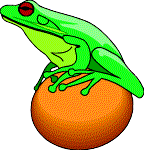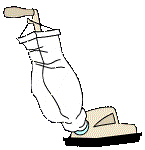
|
|
|||
|
|
|

|
|
|||
|
|
|
The World Book Encyclopedia definition for frogs is:
1. a small, leaping amphibian with webbed feet that lives in
or near water. They are usually tailless and have a smooth skin
and powerful hind legs for leaping. A frog is more agile than
a toad. Frogs lay jellylike clusters of eggs in the water which
develop into tadpoles in the larval stage until they grow legs.
Some common North American Frogs are the bullfrog, the pickerel
frog, the leopard frog, and the wood frog.
2. an animal like this. A tree frog lives in trees.
3. an arrangement of a rail where a railroad track crosses or
branches from another, which guides the flanges to stay on its
track.
4 a triangular pad of elastic, horny substance in the middle of
the bottom of a foot of a horse, donkey or related animal.
5. a perforated or spiky holder for flower stems, placed at the
bottom of a vase or bowl. the nut of a violin bow.
6. the frame of a plow, to which the plowshare, moldboard, and
landside are attached.
also
1. an ornamental fastening for a coat or dress. It usually consists
of a loop and a button which passes through it.
2. a loop or attachment on a belt for carrying a sword, bayonet,
billy club, or other weapon or tool.
![]() Back to top
Back to top
 Comments re wild
caught tadpoles or frogs
Comments re wild
caught tadpoles or frogsSpring is definitely “the” season to go “Tadpole hunting”. In my area I usually head out shortly before or after the Spring Break holiday (centering on March 21) depending upon the weather. Listen to the frog songs! If the frogs are singing, then it’s getting time to head out hunting for frog’s eggs! If you don’t pay attention to the frogs themselves, you may miss getting the eggs. Of course, getting tadpoles is fine... it’s just not as exciting as seeing “your own” eggs hatch!
Before I go “tadpole hunting” I get the tank partially set up at school (my family dreads the spring season because every ditch we drive by gets a “tadpole rating”!). I use a 10 gallon tank with one undergravel filter (or sometimes just a corner filter). I just use gravel from the schoolyard (rinsed) to cover the filter. I also partially set up a small 5 1/2 gallon at the same time. This is for any newt hatchlings, which in my area often come in with the frog’s eggs. I learned, through hard-learned experience, that baby newts (sometimes called mudpuppies) will eat up the tadpoles! Semi-adult newts will gobble up your little froglets. (I lost my very first froglet that way! ) On the other hand I have never been lucky enough to find any toad eggs.
Where do you find the eggs? Look in still ponds, puddles and ditches. Undeveloped areas are the best, of course, but you do not have to venture into acres of wilderness by any means. I was lucky enough to find one seasonal “pond/puddle” (about 10 feet across) which supplied eggs until someone built a townhouse complex on it last year! If you are looking for bullfrog eggs, however, check in permanent ponds or lakes because they may take two or three years to develop into the adult form.
How do you recognize the eggs? The frogs often lay their eggs near the water’s edge around tall grasses or submerged sticks or logs. The eggs are in a large jelly mass. Each egg has a dark center (the tadpole) and a jelly “egg” around it. Try to remove the mass in one swoop of your bucket. I also have used a bleach bottle or a 4 liter plastic milk carton as a scooper. Cut off part of the side so that you have a big “scoop”, complete with handle! Be sure to collect some pond mud, water, and plants too!. If you get teeny little eggs in a mass, these might very well be newt eggs. Toad’s eggs are in long ribbon strips (or so I have read). Additional water (from the tap) must be conditioned properly with tropical fish “chlorine removers”. Rain water is also excellent to use.
The pond plants you collect provide plenty of food during the first days of hatching. Then I switch to commercial baby fish food (it looks like a fine powder). As the tadpoles grow, I add in boiled lettuce or fresh grass and weeds from the school playground outside. (Watch out that you don’t collect from an area which has had insecticides applied.) When the tadpoles start growing legs, I also add in some fresh or frozen brine shrimp or blood worms. Whether the blood worms (from the pet store) are dried or frozen, add only a little at a time. They make the water VERY messy (and stinky!) if they aren’t eaten right away. It is very beneficial to go back to your pond, or even a local ditch, to collect some more water at this time. There is lots of microscopic growth in it. Watch out for predacious mini-beasts lurking in the weeds, however. Dragonfly nymphs and beetle larvae just love tadpoles!
Newts are easy to tell from tadpoles, very early in their development. They have thin bodies and they grow their FRONT two legs first (instead of the back legs, like frogs). They have VERY thin legs and they gobble up bloodworms (and little tadpoles) like crazy! It is really interesting to have newts for a comparison species... but remember... keep them in a separate tank!
Before your tadpoles start turning into froglets, you need to have a secure screen on the top of the tank. The froglets are smaller than the actual tadpoles, so make sure your screen is a fine mesh. If you have the big “bullfrog” tadpoles, of course, you won’t have the same escape problem at all! If you have a light source, be SURE to have it well away from where the froggies can reach. I have had more than one desiccated froggie from getting too close to the lights. You also should have some sort of floating pad so that the little froglets can sit out of the water. Plastic lily pads are fine, but can be expensive! I have used styrofoam meat trays cut into lily shapes. Very functional, although not as aesthetic I’m afraid!
By the time your froglets are losing their tails it is probably
getting close to the end of the school year. Take them back to
the same pond if at all possible. They may require two or three
years to be ready to reproduce, so these little guys need a safe
place to grow up in! I have never tried keeping any of my little
froglets more than one season. It is often illegal to keep local
fauna anyway. You gave them a great start, so let them go!
![]() Back to top
Back to top
 Comments re Frogs
purchased from the Pet Store
Comments re Frogs
purchased from the Pet StoreThere is a fairly wide variety of frogs available from the
local pet store. Be sure to get the exact scientific name of the
one you purchase. Habitat and food requirements may be significantly
different with different species. It will also make a big difference
as to the variety of other species that you can keep in the same
tank.
In 1998/99 my class obtained tree frogs for the first time. While
I haven't had time to write up our experiences, I'd be happy to
answer any email questions!
![]() Back to top
Back to top
Your container should probably be a 10 gallon tank, at the smallest. It needs to be waterproof as well. This is not the time to use a cracked tank unless you are certain that it has been sealed properly. If you are preparing for a basically aquatic frog, you will need to make or purchase some sort of artificial “cliff” or “lily pad” that the frog can occasionally come out on. Plantings will need to be aquatic plants unless you can keep the excess moisture from getting to the roots. Even if you are preparing for a basically land frog, you will still need to provide a pool of water. Tree frogs need some kind of plants to climb as well. There are some magnificent “half and half” aquarium/ terrarium setups available now, but of course they are very expensive. You might also try building your own... silicone seal a piece of glass to make a divider across the bottom of your tank. Fill one side with a layer of gravel, then soil, then moss, and the other side with water. This type of tank, however, will be more difficult to clean than one in which the “pool” ( a plastic tub) can simply be lifted out of the tank.
A screen will be needed for the top of the tank. If you have
a plastic or glass cover which keeps in the humidity, you will
need to arrange for some way to let out excess moisture without
providing an escape route! (eg. a sliding cover with holes, a
screen cover etc.) Some kind of hiding place should be provided
so that the frog can escape from view. Room temperature is generally
sufficient, but check your species information if you have purchased
an exotic species.
![]() Back to top
Back to top
Most frogs enjoy all sorts of live insects, worms, spiders,
caterpillars etc. that are easily found in the garden. You will
need to check on specific requirements from the pet store if you
purchase one of the more exotic species. Crickets, mealworms,
and earthworms can also be purchased from Pet stores. The food
must be alive and must be small enough to be swallowed whole.
If it is not alive, you can try "wiggling" it in front
on the frog to entice eating.
![]() Back to top
Back to top
 Maintenance
MaintenanceThe major maintenance involves keeping the water supply clean.
Some frogs eliminate their wastes while soaking in the water,
and they will also absorb these wastes if the water is dirty.
Depending on whether you have one or several frogs, you should
should replace your water every few days or at least once a week.
Be sure to add the appropriate chlorine remover, just as you would
for a fish aquarium. Wipe down the sides of your tank at the same
time. If you are keeping your frog as a pet as opposed to a short
term “visitor”, you will also need to clean out and
replace the soil occasionally. Check with a proper frog care booklet
for specific information.
![]() Back to top
Back to top
Amphibians first developed about three to four hundred million
years ago. They were a very important stage in evolution, for
from amphibians came reptiles and from the reptiles came birds
and mammals. There are only two basic groups of amphibians left
today: those without tails, the frogs and toads, and those with
tails, the salamanders. Amphibians are linked to both land and
water. They are found around the world, wherever moisture is adequate
and temperature is sufficient for a cold-blooded animal. Some
frogs secrete a poisonous substance from their skin. These are
not suitable for school!
![]() Back to top
Back to top
 Characteristics
Characteristics• Frogs are well known for their leaping ability. The
back legs are more muscular and have webbed feet.
• A frog’s skin is thin enough to let it breathe through
its skin. It has important oil glands which help keep the skin
moist.
• A frog’s eyes are well adapted to peeking out of the
water when the rest of the body is submerged. The eyes have three
lids: an upper, a lower, and a clear, complete lid that protects
the eye when the frog’s eyes are open under water.
• The three part life cycle, with full metamorphosis, makes
the frog an interesting subject to watch develop. Eggs and tadpoles
live in the water, but the adult generally lives on land.
• Tadpoles have gills to breathe underwater, but adult frogs
have lungs.
• A frog’s prey must be alive as the frog is generally
unaware of the prey unless it is moving.
![]() Back to top
Back to top
• Study the basic anatomy of the frog. Look for the head,
eyes, nostrils, eye holes. Describe the unusual eyes. Check the
feet. Count the toes. Look for the webbing on the back feet. Describe
the skin colour and texture.
• Observe the frog’s breathing patterns and eye movements.
Try counting the breaths by watching the throat.
• Observe the frog’s movements. Watch how it jumps.
Measure the distance and/or height.
• Observe the frog watching, catching, swallowing its prey.
• Try different types of food or prey. Watch if the frog
is attracted by certain movements.
![]() Back to top
Back to top
Alderton, D., A Petkeeper's guide to Reptiles and Amphibians, Salamander Books, 1986
Axelrod, Dr. Herbert R., Salamanders and Newts, U.S.A.: T.F.H. Publications, Inc., 1958
Breen, J.F., Encyclopedia of Reptiles and Amphibians, U.S.A.: T.F.H. Publications, Inc., 1974.
de Vosjoli, Philippe, Robert Mailloux, and Drew Ready, Care and Breeding of Popular Tree Frogs (The Herpecultural Library), Advanced Vivarium Systems, Inc. , 1996.
Flick, W., Frogs in the Aquarium, U.S.A.: T.F.H. Publications Inc. Ltd, 1973
Kindersley, Dorling, Amphibian (Eyewitness Book), Alfred A. Knoft, Inc., 1993
Kramer, David C., Animals in the Classroom, U.S.A.: Addison-Wesley, 1989, pp.115-125
Mara, W.P., Breeding and Keeping Frogs and Toads, U.S.A.: T.F.H. Publications, Inc., 1994
Obst, F.J., et al. The Completely Illustrated Atlas of Reptiles and Amphibians for the Terrarium, U.S.A.: T.F.H. Publications, Inc. Ltd., 1988
Simon, Seymour, Pets in a Jar: Collecting and Caring for
Small Wild Animals, Ontario: Penguin Books Canada Ltd., 1975,
pp.37-43
![]() Back to top
Back to top
Amphibian Fact Sheet, Acme Pet Library
good info. on general care
http://www.acmepet.com/reptile/library/amphib.html#intr
Cuban Tree Frog (N. America’s largest tree frog!) (part
of the “Frogland” site)
http://www.teleport.com/~dstroy/info/species/cuban.html
Electronic Zoo- NetVet Amphibians: Frogs and Toads
lots of links to other sites
http://netvet.wustl.edu/amphib.htm
Froggy Page
Interesting site with lots of info., (story books, games etc.)
http://frog.simplenet.com/froggy/index.shtml
Frogland!!!
Excellent resource including weird frog facts, FAQs, and a great
teacher's corner
http://www.teleport.com/~dstroy/froglnd.shtml
Housing Your Pet Frog , (part of the “Frogland” site)
great drawings of the different types of tank setups
http://www.teleport.com/~dstroy/info/housing.html
Interactive Frog Dissection kit (very interesting!)
http://george.lbl.gov/ITG.hm.pg.docs/Whole.Frog/Whole.Frog.html
Minnesota School Frog Project (studying the deformed frogs
found in Minnesota)
Frogs as biological indicators of environmental conditions
http://www.mncs.k12.mn.us/frog/
The Final Croak. Why are the world’s species of amphibians
dying?
http://www.abc.net.au/quantum/info/q95-19-2.htm
Teacher's Corner - many wonderful teaching ideas (part of the
"Frogland Site")
http://www.teleport.com/~dstroy/info/teach/learning.html
|
|
Getting around ...the main TOC |